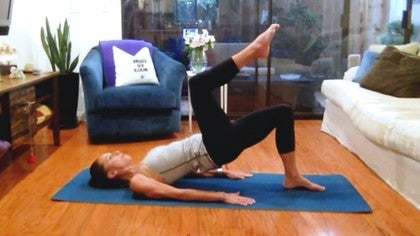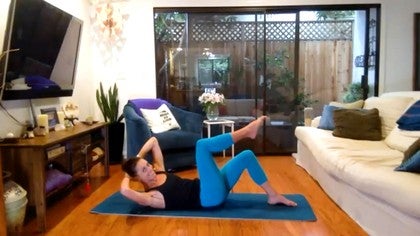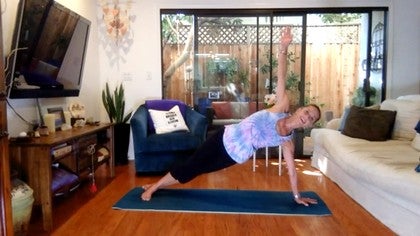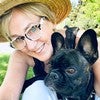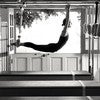Description
About This Video
Transcript
Read Full Transcript
Hi, everyone. Welcome to my house. Thank you for being here. If you're here, you know that today, we're gonna backtrack a little or go back and explore some of the fundamental work, the basic, the basic work. So thank you for being willing to come along with me, to do that.
It's still bizarre to me, that I can't see you, but I know that you're here. I know that there's many, many of us, so thank you for coming. Last week, for example, we had over 100 people together, moving together, here in this house and in our collective houses. So that gives me hope that there are more than just myself and Winnie from the UK. I know she's here.
Hi, Winnie. So anyway, let's get started. So what we'll do today, to begin, is we'll just come down onto our mat, all the way down, onto our back. And we're gonna bring the feet about five to six inches from the back from the sitting bones, from the pelvis. And then we're gonna rest.
(chuckles) We're gonna rest our hands on our ribs. Sorry, I'm laughing, because my cat has taken advantage of this moment, to shred the couch, and he knows that he's not gonna get scolded, because I'm on camera. So resting the hands on the ribs. And then what I want us to do, is I just want us to close our eyes, and without thinking very hard about anything, trying to create any specific breathing pattern, I just want us to take a deep breath in. Just noticing what happens, notice how the chest rises and the belly rises.
And then we're gonna just softly let that go. So we're not doing prescribed breathing at that moment, in this moment, we're just. So, big inhale. And exhale, and then maybe as we just do it that one more time, just one more full, just breath, letting anything else that's unnecessary or in our brains today, go away. And now place one hand on your abdomen and the other hand on the ribs.
And now, this time, as we inhale, what I want us to do, is I want us to, that on the inhale, we're trying to spread the ribs apart under our upper hand and draw down in the tissue underneath our hand that's on our pelvis, right? So the contraction of the abdominals, as we inhale, then as we exhale, feel that deep contraction deepen. Deepen and in order to exhale all the air out of your body, and note here, that as we practice or as we work into that lateral breath, let's do it again. Inhale, the ribs expand, the abdominals drop, and then everything gets a little deeper. Or we feel that sensation of going deep, into the center of the body, with our breath.
No, I'm not gonna make a fly on the floor and breathe all day. We're gonna do one more. So inhale, just, so what I like to play with, is a sense of trying to pull my skin away from my clothing. Now that's difficult in tights, and exhale, but it's an idea that works for me, to give a lot of good feedback. Bring your arms next to your sides and inhale.
Same lateral breathing. Now this time, as we exhale, we're gonna flatten the spine into the ground. So stand on your feet and feel that you could engage through the back, from your legs, and then return back to what's neutral. So where the pelvis lays straight and then arch your back and feel as the back arches, the head kinda slides along the mat, and then return to neutral. And then exhale, we draw the navel to the spine, and we imprint the low back.
So that can be mostly abdominal work there, to create that imprintation, but there can be a little awareness to the back of the legs, as we step into, step into the backs of the legs. 'Cause that's what we're gonna want to turn on. Let's do that one more time. Inhale, arch. Return to neutral.
Exhale flat and now from the flat back, now we are pressing down with our feet, and we're gonna start lifting the spine away from the floor, one bone at a time. So here we. Mat, we take an inhale. (clears throat) Excuse me. And as we exhale, we starts softening.
So we go down, softening through the throat, softening through the ribs, rounding that deep rounding of the lower spine that we just keep that happening all the way, as you move through your lower spine, and then return all the way to your tailbone. And exhale, flatten the spine, stand into your feet. Now what I like to try to find or notice in my own movement exploration, is the weight equal from foot to foot, side to side? And am I wavering? Am I wavering from foot to foot?
Can I feel that there's a shift from side to side? And what I'm hoping, as I ask myself these questions. You to turn them into your personal questions. And what I'm hoping, is as I make that inquiry, into that shift of weight, into my experience, as I move, I hope you guys feel very grounded from side to side, very equal from side to side, as we come down. And now we feel here, that we're using the front.
All the way down. We're gonna do one more inhale. And exhale. So it is my opinion, and I have many opinions, I'll share this one with you, that the basic work, this fundamental work, is where we build the strength for the more advanced work. Now I can do advanced work, and I, next time, will teach you some advanced work, or guide you through some advanced work.
But it's this, this simplistic movement, where we can really focus in on one more time, please, the details, the precision of movement. Rest on the mat and reach the arms towards the feet. So even in these really simple movements, we can create a myriad of physical experiences, that sense of reaching through the arms, the sense of reaching back through the head, the (mumbles) of the body, over the feet, the heels pulling to the fingertips, energize the back. Once we return all the way downward, what I'd like us to do. So what we were doing, is we had our hands resting on our A-S-S, and we were threading the fingers across the bowl of the pelvis.
And what I was saying is, we're lifting one leg, and what I was hopefully giving you an invitation to think about, was your own stability. So what I find difficult is, as that leg moves up and down through space, can I do that without any shifting of my pelvis? None. And can I continue to use that breath that we practiced in the beginning of class, to feel that the tissue underneath my hands go away from my hands? Right, now, if this is done with good precision, let's put that down, now, this is the tough part.
When that leg comes down, and we go to lift the other one up, is there any shifting? Let's be honest with ourselves. I had to work really hard, to navigate no shifting. And down. And the tissue, right?
Skin pulls away from your fingertips. And I know not everyone has the patience to think about this, on this deep of a level. And that's okay. Let's do two more. But I find it interesting.
So I'd like to share my thoughts on it with you. And last one, so now, what we're gonna do, is we're gonna switch the legs. So we're gonna take one down and one up. Now that sense of pulling the skin or the tissue of the lower abdominals away from the hand becomes more difficult, but it's possible. And exhale, as one leg goes down.
And exhale, as the other leg goes down. And inhale, and exhale. Let's do one more time through. Place one leg down, place the other leg down, take the arms down to the sides of the body and taking in here. Now we're gonna exhale, and we're gonna apply that lesson, in a bridge.
So we're rolling ourself up, rolling ourselves up, feeling the weight of the head, feeling that the arms are straight and connected, active reaching, inhale. Now we're gonna stand on the right foot, and we're gonna lift the left leg up off the floor, and we're gonna touch. So as that leg moves through space, even though the pelvis is lifted up in the air, can we find the same sensation of pulling from the waist? Right, pulling from the abdominal area. This is the last two.
And this is the last one, and it's right on time, 'cause I'm (chuckles) about to cramp, I don't know about you. So we're gonna put that leg down. Oh, did anything need to shift? In my world, it did. And now we stabilize, and we lift the right leg, it floats and touches.
So it's not really bio mechanically, the abdominals that are moving the leg, but we can create the sensation from there. Let's do two more. And one more. And then let's see what happens if we take just one leg an inch off the floor and back. And how much do you have to stabilize, as you go from side to side and back.
And one leg, And you might find, is what I'm finding anyway, is that one side is a lot easier to do than the other. So one side and the other, we'll do just one more, one side and then the other. And we'll inhale, and we'll exhale, and go down, moving through the spine, stretching through the spine, and eventually making our way, all the way down to our pelvis. So now let's take our arms and reach them straight up towards the ceiling, with the palms of the hands facing each other. Now going back to that idea of breath, let's practice the breath and move, do some arm movements.
So as we inhale, we feel the ribs expand outwards with the fingertips, the arms hover off the floor. And then as we exhale, we create pressure, right? Imagine that you're using your arms, to squeeze the air out of your body, right? So inhale to open. And exhale.
So in simple movement patterns, it requires some dedication to creation of energy, some conscious thought, right? 'Cause this could be a nothing kind of a feeling as well, or it could be an everything kind of a feeling, where you notice if your arms are moving at the exact same pace, and you're squeezing the air in between your hands, with your upper arms, and then you feel, that as your arms open, they're reaching to both sides of your house. So they get, you get a stretch across the chest. And then we squeeze again, right? Using the arms to mimic their movement of the ribs, as the ribs do lateral breathing.
Let's do one more, inhale wide. And exhale, squeeze. And now inhale wide again, taking the arms down all the way to the ground. So now let's remember what it feels like to use the center of the body for stabilization, as we go to lift one leg up, and then we're gonna lift the other leg up and join the knees together. So from here, we're gonna lift off the right hip, onto the left hip.
We're gonna reach out through the right arm. We're gonna go into a spine twist, and we're gonna come back to center. We're gonna lift off the left hip, onto the right hip, going into a spine twist, reaching out through the left arm. Doesn't really matter which way you're going, it just is easier for me to cue, if I have directions in my brain. So going over in one direction.
What I want you to think about is, pull your navel back towards your spine as deeply as you can, and then deepen that deep, right? (chuckles) That wasn't good words, but, so we find depth, to go over. We might think that we're as deep as we can go, but we just go from there, and we dig in, and we pull back to center. And when I say dig in, I don't really mean like to force. I mean, to mentally find depth.
Right? And over, continuing to alternate, inhale. Mentally fine depth. So we could easily just swing ourself around, right, without a lot of concentration. But there's so much to be found, if you're interested in going searching for it.
Let's do one more And center. So we're gonna place the feet down on the floor. We're gonna, let's keep the knees and feet together today, gonna reach back and bring the hands to the back of the head. And I want us to fully interlock our fingers, fully interlock our hands. So from here, we're gonna curl our head and chest up.
We're gonna curl our head and chest up. This is a little variation on the chest lift that I like to do. So what I want us to do, is maintain the heighth of the chest. Now tuck the tail and do a little mini pelvic curl. So what I'm saying is, lift your pelvis off the ground.
Now as your pelvis goes back down, and we're looking for the tailbone to drop, I want you to only go as low, with your pelvis, as you can keep your spine flat, and I want you to try to lift your chest more. And then we're gonna go down. Yes, it's simple. Is it easy? In my opinion, no.
Exhale, to lift. In fact, lift the pelvis. I believe that if you feel Pilates is easy, you could try harder. And lift up. And go down.
But again, that's just an opinion, and I'll stop sharing them for a minute and talk more about what's happening. So lift the chest, squeeze the legs together. Standing your feet, push down with your feet and curl the pelvis. Now keep pushing down with your feet, as you lower your pelvis down, but also pull your feet back towards your pelvis and lift your chest up more. Oh yeah, we can create all those sensations at the same time.
What do you know, and here we go, we're gonna do it two more times. We curl the head and chest up, squeeze the legs together, standing your feet, push down with your feet, lift your pelvis. As your pelvis goes down, pull your feet towards your tailbone and curl your chest up and inhale. And exhale, as we go back down. And one more time, lifting up.
Feet push, feet pull, pelvis lifts. And come back. Oh, lifting up, up, up, up, up, back. And go back. So now we're gonna talk about rotation.
We're gonna find our chest lift. We're gonna lift the leg closest to the camera, reach across that thigh, so you're holding onto it. Take the other hand underneath the arm. So I'm gonna do a little talking and then we're gonna do more moving. So this rib that's at the back, we want to think of coming across the body, to the pelvis, on this side.
This rib here, you want to think of sliding in, sliding that rib in, so that we have like a funnel shape with our, with our ribs. Now hold yourself up here. This is the building block for many, many, many more difficult exercises. Bring your hands back behind your head, bring your leg down, but this is the one we're gonna practice today, and this is the feeling of being in the right place. Now come to center and go back.
And then we're gonna do that on the other side too. So we come up with the head and chest. We take the leg, oop, did your pelvic shift? Mine did, if I'm honest. We're gonna rotate.
We're gonna take the leg. Now the opposite rib to A-S-I-S or pelvis, the tailbone down, the back of the pelvis on the mat, same side rib pulling in and down, belly button to spine. Hands behind your head. Take the leg down. This is the sensation, the position that we're trying to find, and it is difficult for me.
And go down. So now that we know what we're looking for, let's practice finding it. So inhale, and exhale as we curl up. We're gonna reach behind the thighs. We're gonna deepen in curl.
We're gonna let go. Bring the arms back behind the head. Now inhale. And now see if you can find that same place. And center.
And rotate. And center. And one rib slides, the ribs that you're turning toad. (stammers) Oh, I couldn't say it. I'll say it differently.
The ribs you're turning towards, go towards the spine. The ribs that are coming from the, across, go across the body and all the while, we've got that tissue in our pelvis, our low pelvis, in our thought process. And center. Over. And center.
And over. This is gonna be our last one, you're welcome. And center and all the way back. We're placing the head down, stretching the left leg down onto the floor. We're gonna bring the right leg in, we're gonna stretch it up towards the ceiling.
Oh, it's very early for me, me to straighten my leg (chuckles) today. Ah, my hamstrings. Okay, so you can either keep your knee a little bent, or you could stretch it all the way, straight up. What we're gonna do is, we're gonna draw tiny circles. Inhale.
And exhale. So just keep that movement happening, bent leg or straight leg. And what we're doing here is, we're using the leg on the ground, to stabilize the pelvis, as that leg moves through space. We're just gonna do two more. And one more.
And then we're gonna reverse. We're gonna go out, down around and think about, can you bring your awareness, to pulling the leg towards your body, from the center of your body. Out, around. So all these are building blocks, two more, for exercises that will come, that are more difficult, but I, bend, take the hand, the opposite hand, to knee, so left hand, right leg, right arm out to the side and go into your rotation. Ah, got an adjustment.
And center. I enjoy going back to basics. I'm just gonna check my mic, 'cause I just rolled onto it. I think we're good. Tell me if we're not.
So now we just come, and we take the right leg out straight, and we're gonna stretch the other leg and reach up through the heel and now make a small circle. So the illustration here or the thought process is, what can we do to anchor the pelvis? Well, what I can do, or what we can all do, is we can push down with the leg that's on the floor. And then we can notice that as leg circles in the hip joint, the pelvis stays nice and still. This is the last time here, and then we're gonna come center, and then we, again, go the other way, pulling in and back.
We bring our awareness to the breath and to the sensation of finding the work in the center of the body, to move that leg through space. Just one more. Then we're gonna bend the knee. We're gonna take the left arm out to the side, bring the right hand across the left thigh and come across to the side. Find a stretch.
Maybe taking the head over the arm or taking the gaze out over the arm. Come back to center, stretch both legs out long. Just gonna shift back a little. And take. So here, we're gonna lift up into that chest lift position that we were just practicing.
Now I want us to push the lower back into the ground, and that's how we're gonna move ourselves through space, to come up into a rounded spine. So the shoulders come over the pelvis on the inhale, and then reaching out through the legs, reaching out through the arms, so that oppositional reach, feel the pelvis rotating, rotating, rotating, to let the low back connect to the ground, and then the upper body goes back. And then we're gonna lift the head and chest again. We're gonna imprint the lower spine. We're gonna lift that flex, flexed spine, into our upright position and inhale.
And then exhale, rotating the pelvis, so that idea of not just moving the body as a body, by moving the body segmentally, pelvis first, to find the chest lift, to come back. And let's inhale, to lift the head and chest, and exhale as we curl, finding the round shape. So here, we're lifted. It's a long round, so, yeah, there's abdominals working, but we're also thinking about our back muscles being involved in that shape. And back.
And lift. And roll up. And pause. And are you as invested in your work as you wanna be? So I just asked myself that question quite frequently.
And inhale, noticing the pelvis, does it rock from side to side? Mine wants to go to the left, as I start lifting. So I have to think about that. I tell you those things, just so you, I don't know, not 'cause you need to know, but just because we all have something, and I want us to remember that. So let's sit up.
You can do this with bent knees or you can keep your knees straight. It's up to you. I'm gonna bend my knees a little bit today, because I'm wanting to be kind to myself. So inhale. So remember that rotation, that spinal rotation that we started with?
Well, we're gonna do that now, and we do the same feeling of drawing the abdominals in, as we take the body across and then come back to center. And we draw the abdominals in and we take the body across, and as we're doing that spinal rotation, the arms don't change. They're just reaching side to side, and if that's not a comfortable position for you, another place that I really enjoy being, is to bring the hands behind the head. 'Cause what I like to do here is, pull up on my skull. And so I'm gonna continue here, rotate and then center.
And rotate. And then center. And what I've found here, something that I think about is, if you try to force yourself into this shape, it's much less effective, than if you try to ease your way into this shape. And center. So ease, lift, light.
And center And ease. And center. Let's just do two more. So this one. And notice here, oh, I lied, we're gonna keep moving, so that the feet don't shift from side to side, the knees are side to side.
So we keep the lower body still. Now we're gonna do one more to each side, here's one. And this other. And then we're gonna come back to center, and we're gonna bring the chin into the chest, and we're gonna let the spine round. Then we're gonna just let the hands be soft on the head.
And in fact, take your hands away from your head, put them on your legs somewhere and take, use them to bring you a little bit more forward. And then we're gonna bend our knees, and we're gonna take that same spinal shape that we did in the roll up, and we're gonna bring our feet in. So it's the same long C-shape of the spine. Now what I want us to do is, not just pick our feet up off the floor, but I want us to deepen into this shape, to lift the legs. So again, a process of just thinking about movements slightly differently, or coming at it from an attempt to find.
And exhales. So tipping back, by connecting to the center of the body, it pushes back. And then staying connected to the center of the body, as we come up and balance. And inhale. And exhale.
And inhale. And finding our balance, we're gonna do three more. Deepen, elbows wide. Inner thighs active. If you ever feel like there's not enough to think about, just start thinking of how many pieces of my body, oh, can I use create more work or different sensations?
Right? If we bring awareness to different sensations, the movement itself might feel a little different. So bring the feet down, stretch the legs out and separate them. So again, straight legs are bent, knees, arms are gonna reach forward in front of us, and we're gonna start articulating the spine in this direction now. So we're gonna bring the head down, and we're gonna round down, and as we round down, we're gonna reach out through the feet.
And inhale, just notice where you are, without judging, just notice. And then as we exhale, we're gonna imagine there's a wall behind us, and we're gonna use the front of the body again, to move the back of the body through space and sit back up. And inhale. And exhale, taking the head down, creating sensations, as the body's going forward, the abdominals are pulling back, the shoulders are softly held away from the ears, and you might notice that you went further the second time. It happens all the time.
And then again, we use the front of the body. So we bring our conscious awareness to the place that we want to feel movement happening from, and we let our spine lift in a pretty light way, Right? And inhale. And head goes down. And I am noticing myself going further and further each time. And exhale.
So what is Pilates, but a practice of noticing. It's my favorite thing about it. Let's do one more like that. Going down. You're gonna inhale.
And lifting up. Now we're gonna find some extensions. So we're gonna go down, and we're gonna let our hands come down to wherever they land on our legs. It's gonna be different for different folks. Want us to pull our back out long, in fact, bend your knees and really get your back flat, flat flat.
Then maybe you'll try to straighten your legs a little more. Take the arms, reach them up over your head. Sit all the way up. Open the arms out to the side. They reach forward and we do it again.
We're gonna go down, noticing the stability of the pelvis. Is it stable? Is it still? Lift the back, reach out, get a nice flat back position. Maybe you want to bend your knees, maybe you don't, Reach up with the arm, now feel here, that you're leaning into your hands.
You're reaching out in space. Sit all the way up, open the arms, take them forward and let's go again. Go down. Take the hands down. Find your flat back.
Use your arms. Then let them go, but keep the spinal position. Reach out, reach out, reach out. And sit up. And open.
And we'll do one more. Go down. Take the hands, flatten out the back. Feel equality of weight over your sitting bones. Let go.
Sit up. Open. Now we're gonna make a combination of movements, movements that we've done all in this class. So we go into rotation first. Now the opposite hands, reaching for the opposite foot, and we're flattening the back.
Now as we lift back up, try to get straighter in your spine, open your arms and come to center, and inhale, to lift and rotate. Exhale, to reach. Now reach out in space, Lift up. Open the arms. And center.
And inhale, to twist. And exhale, flattening. So what helps me, as I look for the flatness of the back is, to send the back arm back and reach the front and forward, like the arms are pulling the back flatter. And then open and then center and inhale. And reach.
Keeping the opposite sitting bone down, Meredith and everyone. Reach out. Open. And center. Let's just do one more in each direction.
We take it down. Opposite sitting bone down. Reach out. Open and center. Last one, lift and rotate.
And reach. And lift up. And find your center and take your arms down. What I'd like for us to do now, is to turn onto our side and lie all the way down. Make sure you have enough room in your house, to lift your legs, without running into your sofa.
So what I wanna bring us, where I want us to take our imagination here, is back to that sensation. In fact, put your hand on your pelvis, not lifting the legs yet, but I want you to see if you can find a sense of contrasting there so much, so that you're able to create space between your hand, where you've rested it, and your body, right? It's possible. Okay, so feel that feeling, feel what that feels like. You can keep your hand there, if you'd like, or you can rest your hand down on the floor.
Up to you, but what we're all gonna do is, we're gonna create that contraction. We're gonna use that contraction, to reach out with our legs and lift the legs up. And then we're gonna maintain that contraction, as the legs go down to hover, and we're gonna reconnect every time, mentally, to that area of our body. Now there's more that we can think about. So keep thinking about that, and I'll keep talking.
So we feel that upper waist, really connected, and we feel the lower part of the waist. Maybe it's not lifting off the floor, all the way. I mean, we're all completely different shapes, but it's definitely in our mind, it can definitely work. Right? I don't want anyone to force space under their body.
I just want you to bring your awareness to the connection of the musculature there. And we're gonna do three more. And down. And two more. And down.
And last time, up. And last time, down. Now once the legs come down, we're gonna bend our knees, and we're gonna line the heels up with that. What's the word for the tailbone? The tailbone.
And I'm just gonna put my hand on my pelvis. And what I wanna do is, I wanna make sure that upper pelvis is right on top of my lower pelvis. So imagine a skewer, a straight line, going from greater trochanter, to right hip bone to hip bone. So we feel the evenness of the hip bones. Now we're gonna open and close.
And what we can think about, is pushing up against the end of that range. So your hand is there, just to discover that the pelvis can stay still, right? So you can feel into that feedback, but then we can push into the end of the range. And again, it's a mental energy, that you just have to create, if you're interested in creating it. We'll do three more.
I believe that you are or you wouldn't be here. And two, I am, or I wouldn't be here. And one. And now we're gonna lift that leg up. We're gonna just kinda keep the knees soft.
We're gonna keep our hand there. Notice that the pelvis stays still, and we're gonna make circles. So big, full range of circle. And full range circle. And there's always opportunity to bring awareness back into the center of the body, full range circle.
So these movements that are simple, doesn't mean they are super easy, right? So we can create here, if we think of moving through something sticky, can create a lot of muscular energy. We have four more to go in this direction, then we're gonna reverse. So here's three. Here's two.
And here's one. And then we're simply gonna go the opposite direction. So back, up, around, and down. And back, up, around, and down. And, oh, I just caught my pelvis trying to shift.
So again, we just have to keep checking in, being really honest and, yeah, I don't think I have anything else to add to that. Just be really honest with ourselves, about our experience. You can push down with the leg that's on the floor, to help anchor that part of the body. We have two more, I think, although my accounting skills are less than stellar. But that's how many we're gonna do.
And then we take the leg down, and we help ourself up. We can just bring that, oop, before we do that, let's bring the feet in, sit all the way up, nice and tall, take the arm, this arm, and find a side stretch. And then keep the bottom leg where it is, but bring the top leg around the front of the body, bring it right into the chest and sit down into the hip. So I think it's important to do stretching, after we work a muscle like that. And here, some details, right?
The more you sit down, and you feel connected, and you feel weight on that sitting bone, the more functional, the bigger the stretches, or the better the stretches, the more we can lift our spine, that's gonna affect the stretch too. So this looks like we're just sitting here, but there's activity, thought processes. And then we're gonna unwind. We're gonna take it to the other side. Guys, I have to shift this microphone.
And we changed sides. I never, ever, ever, ever, ever, in the beginning of this year, thought that I would be teaching on the floor of my house, but here we are. And it's fun. I love it. Okay.
So we take the hand to the pelvis. Oh, what I just noticed in my body, is that my upper pelvis is a lot further behind my bottom pelvis. So that's useful information. So make sure the hips are lined up, one on top of the other, create the sensation of pulling, creating space between your hand and your body. And then just remembering that sensation.
That's what we're gonna use, to try to pick the legs up. Exhale. And down. And exhale. And down. (chuckles) I was so surprised, that I had to pick my head up and look, am I actually in a straight line?
I don't feel straight, but I looked, and I do believe that I am. Another check. So keep checking in with that lower pelvic space, right? That deep, low abdominal contraction. The things that we spoke about, this is another moment where you can think about your skin pulling away from your clothes, the upper waistline, of course, the lower waistline.
Many, many, many things to think about, in such a simple, simple movement. And let's do three more. Here's one. And down. And two.
And down. Notice what the shoulder blade is doing. Are you pushing down with your arm? Are you lifting your shoulder blade into your ear, or are you just having your hand softly down? Bend your knees.
Bring your heels aligned with your tailbone, take your hand to your pelvis, orient so the hips, one hip's right over the other hip. So I use this bone here, on the side of my pelvis, a greater trochanter to measure. And we go up and down. And up. And down.
And up. And down. And up. So again, we spoke of pushing into the edge of that range, creating our own sense of resistance. Maybe pushing down with the leg that's on the floor.
Let's do three. And down. Two. And down. One.
And down. And now go in a circle around. And down. And around. So your circle can be as big as you want it to be.
The only, the only guidance, is that we try to not let the spine shift. The pelvis stays still, the leg is just moving around in it's hip joint, and the muscles that do that, are having to work. We have four more. So your hand on your pelvis can assist you, in noticing what's going on. Are you leaning?
Are you shifting? This is the last one. And then we're gonna go in the reverse. So you feel the back of your leg work, as you push back, then come up, around, and down. And push back, around, and down.
And push back, around, and down. And keep lifting through the lower waist and keep finking, thinking, not finking, thinking about what's happening in the center of your body. And I think four more oughta do it. And three. And if you're fussy about being exactly the same on both sides, and I didn't make that happen for us, please feel free to organize differently.
I know many of us are teachers, so the counting problem, we all get it taught. We can talk, right? We can talk, scooting the feet in, or count. And personally, I like to talk about ideas and sensations, rather than hear, "One, two, three." So. Another opinion from me.
Lucky everyone! Let's go on our stomach. (grunts) So what we're gonna do to start, is we're gonna bring our forearms just to the outside edges of the mat. So mine actually are on my floor, not on my mat. And I'm just gonna let my head hover. You could actually put your forehead down, if you want to, on your, on your mat.
We're gonna engage through the backs of our legs. So my knee caps are no longer on the floor, but I'm not thinking, I'm not doing that from the front of my leg, I'm doing that, by energizing the back of my body. The next place we're gonna put awareness, is into the abdominal. So feel that you're attempting, endeavoring to lift away from the floor, with your abdomen. It doesn't mean you will, just means there's intention.
Now what I want you to create, is a sense of taking the head forward and pulling back and actually allow your arms to glide. And if you have carpet, you might actually be able to move your arms on your carpet, slide them. A little bit, not a lot. I have a hard floor, as you can see, so that doesn't work, but the sensation works. So what it is, is it's not a hand glide, it's a scapula glide.
So feel the shoulder blades draw down the back. That action of drawing down the back with the scapula, we can start sending the elbows in that direction and the spine comes forward. So the thought, is maybe not lifting up as high as we can. Again, head forward, scapula, shoulder blades down, but instead, creating a sense of lengthening, as we lift the upper back, in an effort to find a lot of upper back extension. And return.
Let's do three more. So head and chest. Arms glide. Reach out. Are your abdominal still working?
Yes? Good. And back. And are the backs of your legs still energized? Yes?
Good. And one more. Is it crazy when I talk to myself? I'm not talking to myself, I'm talking to you, and I'm answering for you. So that's what's happening.
Now hold here. Take your arms out in front of you. So just on the ground. We're gonna keep one hand down, and we're gonna lift the left arm and the right leg. And we're gonna go down.
And we're gonna lift the right arm and the left leg. And we're gonna go down. So just continue that alternating pattern, one arm, one leg, and what I want us to think about, is it's not the height of the leg, that we are most curious about or most interested. It's the height of the arm. 'Cause the arm is where are we gonna feed into our upper back, right?
So as you continue to alternate, let the leg stay low, but lift the arm high. So in the, in my body, the sensation is, is that the leg is reaching and hovering, and the arm is helping me really generate upper back awareness. We're gonna do three more of each. Really important movement, this bilateral movement, for our back muscles. And two more, stretching the arm and the leg away from each.
And back. And away. And back, and by two, I mean two on each side. So there's one more, left. And back.
And reach. And back. And then allow your body to rest for a moment, maybe rocking the pelvis side to side, and then use your arms to help you up, and bring your knees in underneath you, and take your pelvis back towards your feet, and stretch your arms long, onto the mat in front of you. Don't worry if the shoulder blades lift up. Just reach those arms in such a way, that it feels like you can stretch your back.
And then let's walk the hands over to one side. And we'll stretch that side of the body. And then we'll come back to center. Nice and simple. Then we'll stretch that side of the body, so I'm leaning.
Then come back to center. And what we're gonna do next, is we're gonna take our hands underneath our knees, and we're gonna come into a 4-point kneeling position. And we're gonna inhale. So we're gonna do some spinal moving. I want us to push our shins down into the floor.
We're gonna tuck the tail. So all of this spinal shape, all of these spinal movements, we've done in various different places today. And now we're gonna lift the chest. And what I, I guess I'm, the fact that I needed to say that, or felt that I needed to say that, is that I feel that it illustrates the fact that these really simple movements are inherent, in our work. So lift the chest.
Because each more advanced exercise, and I'm not speaking about the master level exercises even, but just even the intermediate work is all based. So just alternating lower spinal bend, straight body, upper spinal bend, straight body. It's all based in this. It's all based in this fundamental work. Push down with your shins, as you round your low back.
Come back to a straight body. As you arch your back, pull your arms towards your knees and your knees to your arms. There's some energetic contraction that works there. There's no movement, actually, but there's feeling. And then center.
And let's do that two more times through, round, push down with your hands, push down with your knees, lift up with your abdominals and find straight. So there's many different ways, to create different types of sensation, just by thinking about what you're doing differently. Let's do one more time. Choose your favorite cue and do it. And center.
And arch the back. And center. And then one last time. Lean back, in a sit, back over our seat. We're gonna reach our arms more forward.
We're gonna take that stretch through our spine. We're gonna inhale there. And as we exhale, we're gonna lift up, go slow. Let your arms glide along your mat. So by doing that, I'm able to find a really nice stretch, and I hope you are too.
So we're coming up. Eventually the palms of the hands have to come up. Eventually the hands will end up near the outsides of the thighs, and then as they end up near the pelvis, we can lift our eyes. And let's close our eyes. Or if you don't wanna close your eyes, you can simply soften your gaze.
And I just want us to take a moment and bring our awareness to the quality of sensation, in our bodies, right? And I don't know what that is for you. I know what it is for me, but I just wanna take a moment, to recognize that the quality of choice that we make when we choose to move our bodies, can resonate even after we have finished. And I hope that we can take that sensation, and hopefully it's a positive one, and bring it forward into the rest of our day, today. Maybe it's nighttime, maybe it's morning time, who knows, but enjoy the rest of your day.
And thank you so much for coming to my house and doing class with me. And next time we are here together, in my house, we'll kick it up a notch and do some advanced work. So hope to see you then as well.
Pilates with Meri Rogers: Zoom from Meri's Living Room
Comments

You need to be a subscriber to post a comment.
Please Log In or Create an Account to start your free trial.
